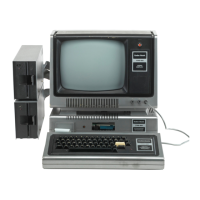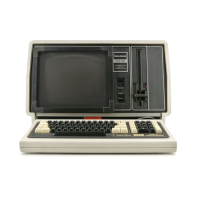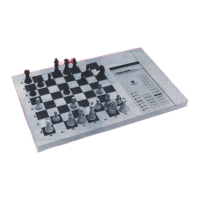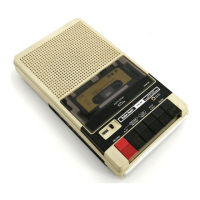The
RS-232-C
Interface requires four power supply voltages
(+5,
—5,
+
1 2V
and
—1
2V). The
Expansion
Interface provides
the
+5V supply
from which the other voltages are derived by using
a DC-to-DC
converter. The DC-to-DC converter
used in the
Radio Shack
RS-232-C Interface
inputs +5V
and outputs
+12V
and
-12V.
A simple resistive voltage divider
is used with the
—1
2V
to
produce the
—
5V
supply
(refer to Schematic Diagram).
DC-to-DC
converters are inherently
noisy and must be properly
decoupled
from the input supply and
the
outputs must be properly
filtered.
LI
,
L2, CI
,
CIO, CI
1,
C3 and C9 perform this
decoupling
and
filtering function.
Terminal
Program
The
Following
Hardware
is Required:
*
TRS-80
LEVEL
II
with
16K RAM
.*
Expansion
Interface
with
RS-232-C
installed.
The
"TERM"inal
program
will
cause
the
TRS-80/RS-232-C
to
function
as a full
duplex
terminal which
displays
ASCII
encoded
text
inputted
from
the RS-232-C
port,
and which
outputs
keyboard
input to the RS-232-C
port. (A
complete
listing
of the
TERM
program
is provided
later on in this
Manual.)
RS-232-C
Input
to
Display
Activation
of program
clears the
screen
and the
cursor
will
be
positioned at
the
upper
left. As text
is input,
it
is displayed
and
the
cursor
increments
to the right.
Line
overflow
goes onto
the next
line
(is
not
truncated).
As the
screen
is filled,
incoming
text causes
it to roll-up
(scroll)
with
the new
text
directed
to the
bottom
of the
screen.
Back
space
(hex
08)
and return
(hex
0D)
are
recognized and
executed
by the
display
program.
Other
ASCII
control
codes
are
ignored.
Delay
periods
are required
(null
[hex
00]
) after return
at
high
baud rates
(1200, 2400,
etc.)
to
allow
the
display
to
scroll
as
indicated
in Table
7.
20

